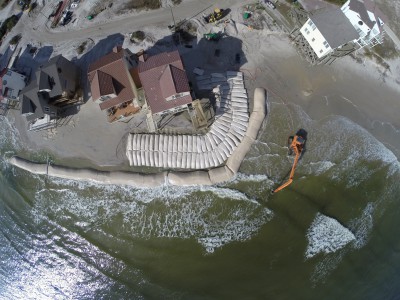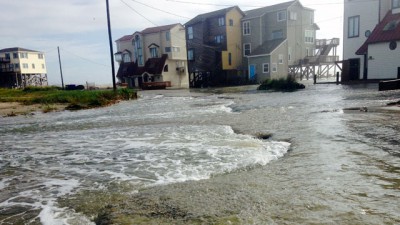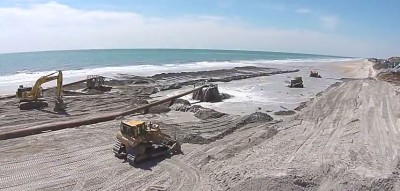
NORTH TOPSAIL BEACH – For the second time in little more than a year, North Topsail Beach is asking for a major permit variance to keep temporary sand control structures in front of the sandbag wall armoring the erosion-battered shore at the north end of town.
The request to the North Carolina Division of Coastal Management was made after the town received its second notice of violation in just over a year for failing to uphold the terms of the permit.
Supporter Spotlight
The town was supposed to remove a geotextile tube, or Geotube, and other temporary structures after the completion of a channel realignment project or by June 30, according to the June 3 notice.
Geotube is the registered trademark of the multinational corporation TenCate for its large, sand-filled sleeves of fabric that are installed in a trench parallel to shore. The tube here was used as a breakwater to allow workers to build a super-sized sandbag wall to protect properties imminently threatened by erosion at the north end.
The New River Inlet maintenance project, which included dredging and sand placement on the beach, was finished in late April, according to DCM’s notice.
The town was given two options – remove the containment tubes, the scour apron and chock tubes within 30 days of the notice or apply for a Coastal Area Management Act major modification variance requesting the structures stay in place.
North Topsail Beach leaders chose the second option, submitting to the division earlier this month a request to allow the tubes to stay put until 2022. DCM accepted the application as complete on June 14.
Supporter Spotlight
Doug Huggett, the division’s manager of major permits, did not return a call seeking comment, but in an email responding to questions about the notice of violation, Sarah Young, the division’s public information officer, stated that the division anticipates denying the town’s request.
“Then the town will have to ask for a variance from the Coastal Resources Commission,” Young wrote. “If the CRC grants the variance then Geotubes may be allowed to stay until 2022.”

North Topsail Beach Town Manager Stuart Turille declined to answer questions about the variance request. He referred questions to town attorney Brian Edes.
“This is a sensitive area that our town attorney’s spearheading,” Turille said.
Edes did not return calls seeking comment, nor did the town’s mayor, Fred Burns.
DCM is currently receiving comments from review agencies and the public on the variance request. Public comments may be submitted “until the date in which DCM takes final action on the permit,” Young stated.
The agency will “work diligently” with the town to agree on specifics of the variance request prior to the CRC’s mid-September meeting, according to the notice.
If the CRC denies or does not address the request at that meeting, the town will have to remove the tubes by September 30, Young said.
In late November 2014, about a month after DCM issued a CAMA major permit for the town to build a sandbag revetment at the north end, the CRC granted a variance allowing construction of wall of sandbags substantially larger than the commission’s rules allow.
The permit originally authorized a sandbag wall six feet high with a 20-foot base width in the inlet hazard area. The CRC permitted the structure to be built 12 feet tall and 45 feet wide.
The sandbag wall is permitted through November 2022 and is part of the town’s ongoing efforts to stabilize the shoreline south of the inlet.

Half of the more than $2 million project was funded through a special fee assessed to 39 properties the town says benefit from the project. The town paid for the other half.
The wall of bags extends 1,450 feet from an existing sandbag structure in front of a condominium complex.
The commission’s 2014 variance also authorized the tube in front of the sandbags to protect the wall that is protecting 20 duplexes.
The tube was supposed to be removed after the wall was built. The project was completed in February 2015 and the tube remained.
That March, DCM sent a notice of violation. At its July 2015 meeting the CRC granted the now expired variance.
The CRC is considering making several amendments to new sandbag rules the North Carolina General Assembly passed last summer. The new regulations loosened requirements for sandbag removal and also allow the structures to protect vacant lots adjacent to properties where sandbags have been permitted.
While discussing permanent sandbag rules during its May meeting, the commission agreed to keep Geotubes as an alternate erosion control structure at inlets, but not on the oceanfront.
In an effort to curb severe, chronic erosion on the oceanfront south of New River Inlet, North Topsail Beach implemented the New River Inlet channel realignment and beach restoration project.
The project was designed to mitigate erosion by causing sand to naturally build up on the north end.
The first phase of that project, including re-nourishing 1.5 miles of beach with sand removed from the channel, was completed in January 2013.
The fifth phase began near the end of March and was finished about a month later.
In the meantime, discussions about future beach erosion mitigation at the north end of Topsail Island have turned more and more toward building a terminal groin at the inlet.
Turille recently asked Onslow County Commissioners to front half – $250,000 – to pay for an environmental impact study of the proposed structure and permitting.
County commissioners prefer the town broaden the study to look at all options, not just a terminal groin.
During their June 20 meeting, Onslow commissioners unanimously voted to enter into an interlocal agreement with the town to fund $250,000 for such a study. If the North Topsail Board of Aldermen accept the terms, the board will revert it back to commissioners, who would then make an amendment to the county’s newly adopted fiscal 2017 budget.
Terminal groins are wall-like structures usually constructed of wood, stone, steel or concrete and built perpendicular to the coast.
North Topsail Beach is among a handful of North Carolina beaches that have either received or are pursuing permits to build terminal groins after the General Assembly in 2011 repealed a decades-old ban on hardened erosion-control structures on the beach. State legislators are allowing up to six structures to be built on the coast.







